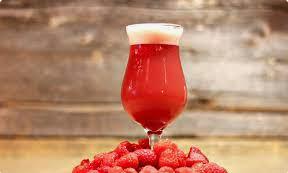Have you ever wanted to try something different with beer but weren’t quite sure what it would be?
Sour beers are an excellent option for those looking to step outside of their comfort zone. It has been brewed with unique hops, yeast, and other ingredients, and sour beer is a unique take on traditional craft beer.
Whether you’re a beer aficionado or someone just getting into craft beers, sour beers are the perfect way to expand your pallet.
Let’s take a look at these tantalizingly tart brews and how to properly enjoy them. Sit back and enjoy reading!
What Is Sour Beer?
Sour beer refers to any style of beer that has been intentionally made acidic or tart through the use of wild yeast or bacteria.
The most commonly used bacteria in sour beer production is lactobacillus, which is found in yogurt and other dairy products.
These bacteria break down the sugars present in the beer and produce lactic acid, which gives the beer its distinctive sour flavor.
Other styles of sour beers may also include fruits such as cherries, raspberries, or cranberries for added flavor and sweetness.
Sour beers can range from light and refreshingly tart to dark and intensely tangy depending on the type of yeast used during fermentation and the ingredients added after fermentation has been completed.
There are many different varieties of sours available on the market today, allowing you to find one that best suits your taste buds!
CHECK OUT: Different Types of Beer
Types Of Sour Beers
Sour beers are gaining in popularity as craft beer enthusiasts develop a greater appreciation for flavorful, unique beer styles.
Sour beers come in many different varieties, from fruity Berliner Weisse to tart lambics, and each type has its own distinct flavor profile.
Whether you’re just getting into sours or have been enjoying them for years, there’s something for everyone in the world of sour beers.
From light-bodied gose to dark and roasty Flanders Red Ale, sour beers can provide drinkers with an exciting experience like no other.
Let’s take a closer look at some of the different types of sour beer available!
Berliner Weisse
One of the oldest styles of sour beer still in production today. This light and effervescent style is usually characterized by bright acidity and mild wheat malt character.
Fruited versions are becoming increasingly popular, with brewers adding fruit purées to intensify the flavor profile.
These highly fruity sours range from sweetly tart raspberry Berliners to intensely sour Gose-style beers made with sea salt and coriander.
Flanders Red Ale
Another popular sour beer style that offers a more full-bodied and malty taste than Berliner Weisse.
The style originated in Belgium hundreds of years ago and is still brewed around the world today. Oftentimes labeled “Oud Bruin”, these dark reddish ales have an acetic acidity with notes of caramelized sugar and dried fruit flavors like raisins or prunes.
Many brewers age these beers for months or even years on oak barrels imparting additional complexity from both Brettanomyces yeast and tannic wood flavors.
Lambic Beers
Probably one of the most recognizable forms of spontaneous fermentation that began centuries ago when Belgian brewers realized their ales were becoming spontaneously acidic due to airborne wild yeasts common in the area.
Unblended lambics boast strong aromas of wet hay, barnyard funk, and tart citrus while brettanomyces yeast can introduce earthy flavors reminiscent of horchata or pear cider depending on how they’re aged or blended with other styles such as Flemish Red Ales or fruits like a cherry puree.
These are just a few examples of the wide variety of exciting sours available today! No matter which type you choose to sample first, you’ll be sure to find something that tickles your taste buds and provides an unforgettable experience!
What Makes Sour Beer Different?
The difference between sour beer and other types of beer lies in the brewing process. With traditional beers such as lagers and ales, brewers use regular yeast strains to ferment the wort (the liquid obtained after mashing grains or other ingredients).
For sour beers, however, brewers use wild yeasts and bacteria that produce lactic acid during fermentation, giving the beer its distinctive tart flavor. This process also gives the beer its characteristic hazy appearance.
Brewers often add fruit or spices to sour beers as well to enhance their flavor profiles. Many breweries are experimenting with different fruits and spices to create unique flavors for their sour beers.
Commonly used fruits include cherries, raspberries, peaches, apricots, blueberries, cranberries, and mangoes; while spices like coriander seeds, cumin seeds, and ginger root are also being used with increasing frequency in sour beers.
How To Enjoy Sour Beer?
The best way to enjoy a sour is by serving it cold – between 40-50 degrees Fahrenheit (5-10 degrees Celsius).
This will help bring out all of the flavors present in the beer while still allowing some subtlety in taste.
When pouring a sour, make sure not to shake or agitate it too much as this could cause excess carbonation which can ruin your experience. Instead, pour slowly over an ice cube if needed so that only minimal CO2 escapes from the bottle.
For best results, serve your sours in a tulip glass or stemmed goblet so that you can inhale all of its aromas before tasting it.
Additionally, it’s important not to pair sours with overly sweet foods as this could mask some of its more subtle flavors. Instead, opt for foods with salty or umami notes so that you can get the full effect from your chosen brews!
Brewing Process
Traditional sour beer brewing involves using wild yeast strains such as Brettanomyces bruxellensis or Brettanomyces lambicus which give the finished beer its signature tart flavor.
The resulting beer will often have notes of wine or vinegar, depending on how long it has been aged.
Some brewers add fruits such as cherries or raspberries during the aging process to create even more complexity in the flavor profile.
Additionally, some brewers use bacteria such as Lactobacillus or Pediococcus during the fermentation process to create an even more intense sourness in their beer.
Serving Suggestions
Sour beers can be enjoyed on their own or paired with foods that can bring out their flavors even more.
Since they have a sharp acidity to them, they pair nicely with dishes that have contrasting flavors such as sweet desserts like chocolate cake or rich cheeses like brie or camembert cheese.
They also go well with sharp cured meats like prosciutto or salami as well as fresher fish dishes like ceviche or sushi rolls.
Food Pairings
Sour beers pair well with a variety of foods due to their tartness. They can be served as an aperitif before meals or enjoyed during meals alongside dishes like grilled fish or chicken with citrus-based sauces; salads; goat cheese; sushi; charcuterie boards; pickled vegetables; cured meats; and desserts like poached pears or crème brûlée.
These foods are the perfect pair for sour beers and you can feel their enticing flavor of it while drinking. Aside from that you can take a look at the menus catalog or ask some experts for suggestions.
Conclusion
Whether you are an experienced sour beer connoisseur or a novice just diving into the world of The Tangy Taste of Sour Beers is sure to leave a lasting impression. With inventive recipes, unique flavor combinations, and refreshing takes on classic styles, sours can be the perfect addition to any craft beer enthusiast’s collection. So grab a glass and get ready for your taste buds to be tantalized!





